Impact of Stone Powder Content on Corrosion Resistance in Reinforced Concrete under Stray Current and Chloride Interactions
Abstract
:1. Introduction
2. Selection of Fine Aggregate
2.1. Particle Size Distribution
2.2. Physical Properties of Fine Aggregates
3. Indoor Testing
3.1. Materials
3.2. Concrete Preparation and Testing Conditions
3.3. Test Methods
3.3.1. Stray Current Corrosion Simulation Test
3.3.2. Electrochemical Testing
3.3.3. Performance Test of Corroded Rebar
3.3.4. Determination of Chloride Ion Content
3.3.5. Microscopic Detection
4. Test Results and Analysis
4.1. Change in Polarization Resistance
4.2. Variations in Corrosion Current Density
4.3. Evolution of Mass Loss Rate
4.4. Tensile Strength of Corroded Steel Bars
4.5. Chloride Ion Content Variation in Concrete
4.6. Scanning Electron Microscopy (SEM) Analysis
4.7. Mercury Intrusion Porosimetry (MIP) Analysis of Mercuric Pressure
4.8. Discussion
5. Conclusions
- Notable variations were observed in the physical properties of different types of manufactured sand. When the physical properties of manufactured sand closely matched those of river sand, the overall corrosion resistance of the manufactured sand group outperformed that of the river sand group. This underscores the beneficial role of stone powder in enhancing the corrosion resistance of manufactured sand concrete.
- Within the range of stone powder content values explored in this experiment, it was evident that higher stone powder content correlated with increased corrosion resistance and improved post-corrosion performance of steel reinforcements. Simultaneously, the concentration of free chloride ions within the concrete decreased as stone powder content increased. Manufactured sand containing 8% stone powder exhibited the highest polarization resistance, the lowest corrosion current, the least mass loss, and the highest post-corrosion tensile strength of the reinforcements, indicating superior resistance to chloride ion transport.
- The SEM results indicated that prior to corrosion, both the quantity and width of microcracks in the concrete gradually decreased as the stone powder content increased. This observation suggests that an appropriate quantity of stone powder served a dual function, acting as both an activator and a filler within the concrete. This dual role contributed to the enhancement of the microstructure of concrete. However, following stray current corrosion, the structure of hydration products within the manufactured sand concrete was compromised, leading to a more porous, loose structure. This transformation underscored the erosive damage caused by stray current and chloride ion solutions to the concrete structure.
- The results of the mercury pressure test conducted after 30 days of stray current corrosion indicated that the concrete porosity of the river sand group was the highest. In contrast, the concrete porosity of the manufactured sand group essentially decreased with the increase in stone powder content. This observation demonstrated the beneficial impact of stone powder on the microscopic pore structure of the concrete.
Author Contributions
Funding
Data Availability Statement
Conflicts of Interest
References
- Anh, L.H.; Mihai, F.-C.; Belousova, A.; Kucera, R.; Oswald, K.-D.; Riedel, W.; Sekar, N.A.; Schneider, P. Life Cycle Assessment of River Sand and Aggregates Alternatives in Concrete. Materials 2023, 16, 2064. [Google Scholar] [CrossRef] [PubMed]
- Aghajani, A.; Urgen, M.; Bertolini, L. Effects of DC Stray Current on Concrete Permeability. J. Mater. Civ. Eng. 2016, 28, 04015177. [Google Scholar] [CrossRef]
- Pan, C.; Geng, J.; Ding, Q. Stray Current Affects the release of bound chloride ions in hydrated cement paste. Int. J. Electrochem. Sci. 2018, 13, 6098–6111. [Google Scholar] [CrossRef]
- Chu, H.; Wang, T.; Guo, M.Z.; Zhu, Z.; Jiang, L.; Pan, C.; Liu, T. Effect of stray current on stability of bound chlorides in chloride and sulfate coexistence environment. Constr. Build. Mater. 2019, 194, 247–256. [Google Scholar] [CrossRef]
- Ding, Q.J.; Geng, J.; Hu, S.G. The effect of stray current on the process and threshold concentration of chloride ion causing steel bar corrosion. In Proceedings of the 1st International Conference on Microstructure Related Durability of Cementitious Composites, Nanjing, China, 13–15 October 2008. [Google Scholar]
- Wu, P.; Zhu, X.; Xu, L.; Peng, W.; Zhao, G. Effect of stray current coupled with chloride concentration and temperature on the corrosion resistance of a steel passivation film. Electrochem. Commun. 2020, 118, 106793. [Google Scholar] [CrossRef]
- Bertolini, L.; Carsana, M.; Pedeferri, P. Corrosion behaviour of steel in concrete in the presence of stray current. Corros. Sci. 2007, 49, 1056–1068. [Google Scholar] [CrossRef]
- Tang, K. Corrosion of discontinuous reinforcement in concrete subject to railway stray alternating current. Cem. Concr. Compos. 2020, 109, 103552. [Google Scholar] [CrossRef]
- Zhang, D.M.; Huang, Z.K.; Wang, R.L.; Yan, J.Y.; Zhang, J. Grouting-based treatment of tunnel settlement: Practice in Shanghai. Tunn. Undergr. Space Technol. 2018, 80, 181–196. [Google Scholar] [CrossRef]
- Li, Y.; Xu, C.; Zhang, R.; Liu, Q.; Wang, X.; Chen, Y. Effects of Stray AC Interference on Corrosion Behavior of X70 Pipeline Steel in a Simulated Marine Soil Solution. Int. J. Electrochem. Sci. 2017, 12, 1829–1845. [Google Scholar] [CrossRef]
- ASTM C33/C33M-18; Standard Specification for Concrete Aggregates. ASTM International: Washington, DC, USA, 2018.
- JIS A5005-2020; Crushed Stone and Manufactured Sand for Concrete. JIS: Tokyo, Japan, 2020.
- AS 2758.1-201; Aggregate and Rock for Engineering Purposes-Concrete Aggregates. Standards Australia: Sydney, Australia, 2014.
- EN 12620:2013; Aggregates for Concrete. CEN: Brussels, Belgium, 2013.
- GB/T 14684-2022; State Administration of Market Supervision and Administration. China Standard Publisher: Beijing, China, 2022. (In Chinese)
- Bonavetti, V.; Irassar, E. The effect of stone dust content in sand. Cem. Concr. Res. 1994, 24, 580–590. [Google Scholar] [CrossRef]
- Nehdi, M.; Mindess, S.; Aïtcin, P.-C. Optimization of high strength limestone filler cement mortars. Cem. Concr. Res. 1996, 26, 883–893. [Google Scholar] [CrossRef]
- Li, H.; Wang, Z.; Sun, R.; Huang, F.; Yi, Z.; Yuan, Z.; Wen, J.; Lu, L.; Yang, Z. Effect of different lithological stone powders on properties of cementitious materials. J. Clean. Prod. 2021, 289, 125820. [Google Scholar] [CrossRef]
- Wu, H.; Shen, B.; Ma, K.; Xuan, D. Assessment of mechanical properties of C80 concrete prepared with different stone powder contents by a statistical analysis. J. Build. Eng. 2022, 56, 104754. [Google Scholar] [CrossRef]
- Ahmed, A.E.; El-Kourd, A.A. Properties of concrete incorporating natural and crushed stone very fine sand. ACI Mater. J. 1989, 86, 417–424. [Google Scholar]
- Zhang, M.; Xu, J.; Li, M.; Yuan, X. Influence of Stone Powder Content from Manufactured Sand Concrete on Shrinkage, Cracking, Compressive Strength, and Penetration. Buildings 2023, 13, 1833. [Google Scholar] [CrossRef]
- Xu, S.; Zeng, L.; Li, C.; Bian, M.; Wang, Z. Experimental study of shrinkage and permeability characteristics of stone powder. Fresenius Environ. Bull. 2018, 27, 4156–4161. [Google Scholar]
- Li, B.; Wang, J.; Zhou, M. Effect of limestone fines content in manufactured sand on durability of low- and high-strength concretes. Constr. Build. Mater. 2009, 23, 2846–2850. [Google Scholar] [CrossRef]
- Xie, K.Z.; Bai, M.Y.; Qing, Z.G.; Li, J.; Ge, B.Z. Study on durability of manufactured sand based on stone powder content. Sci. Adv. Mater. 2018, 10, 1608–1614. [Google Scholar] [CrossRef]
- Thangapandi, K.; Anuradha, R.; O Awoyera, P.; Gobinath, R.; Archana, N.; Berlin, M.; Oladimeji, O.B. Durability Phenomenon in Manufactured Sand Concrete: Effects of Zinc Oxide and Alcofine on Behaviour. Silicon 2020, 13, 1079–1085. [Google Scholar] [CrossRef]
- Yang, X.; Pan, M.; Zheng, S.; Liang, J.; Tan, M.; Rong, H. Influence of stone dust content on carbonation performance of manufactured sand concrete (MSC). J. Build. Eng. 2023, 76, 107341. [Google Scholar] [CrossRef]
- Zheng, S.; Chen, J.; Wang, W. Effects of Fines Content on Durability of High-Strength Manufactured Sand Concrete. Materials 2023, 16, 522. [Google Scholar] [CrossRef]
- Cao, C.N. Principles of Electrochemistry of Corrosion; Chemistry and Industry Press: Beijing, China, 2008. (In Chinese) [Google Scholar]
- Anita, N.; Joany, R.M.; Dorothy, R.; Aslam, J.; Rajendran, S.; Subramania, A.; Singh, G.; Verma, C. Linear polarization resistance (LPR) technique for corrosion measurements. In Electrochemical and Analytical Techniques for Sustainable Corrosion Monitoring; Elsevier: Amsterdam, The Netherlands, 2023; pp. 59–80. [Google Scholar]
- Poursaee, A. Potentiostatic transient technique, a simple approach to estimate the corrosion current density and Stern–Geary constant of reinforcing steel in concrete. Cem. Concr. Res. 2010, 40, 1451–1458. [Google Scholar] [CrossRef]
- Andrade, C.; González, J.A. Quantitative measurements of corrosion rate of reinforcing steels embedded in concrete using polarization resistance measurements. Mater. Corros. 1978, 29, 515–519. [Google Scholar] [CrossRef]
- Wu, Z.; Lian, H. High Performance Concrete; China Railway Press: Beijing, China, 1999. (In Chinese) [Google Scholar]
- Lei, M.; Peng, L.; Shi, C. An experimental study on durability of shield segments under load and chloride environment coupling effect. Tunn. Undergr. Space Technol. 2014, 42, 15–24. [Google Scholar] [CrossRef]
- Song, H.-W.; Pack, S.-W.; Ann, K.Y. Probabilistic assessment to predict the time to corrosion of steel in reinforced concrete tunnel box exposed to sea water. Constr. Build. Mater. 2009, 23, 3270–3278. [Google Scholar] [CrossRef]
- Schaetzel, P.; Auclair, B. The generalized multicomponent Nernst–Planck diffusion equation—Diffusion and self diffusion coefficients. Electrochim. Acta 1998, 43, 3375–3377. [Google Scholar] [CrossRef]
- Menadi, B.; Kenai, S. Effect of cement type on the transport properties of crushed sand concrete. In Proceedings of the 2011 International Conference on Multimedia Technology (ICMT), Hangzhou, China, 26–28 July 2011; pp. 6318–6321. [Google Scholar]
- Menadi, B.; Kenai, S.; Khatib, J.; Aït-Mokhtar, A. Strength and durability of concrete incorporating crushed limestone sand. Constr. Build. Mater. 2009, 23, 625–633. [Google Scholar] [CrossRef]

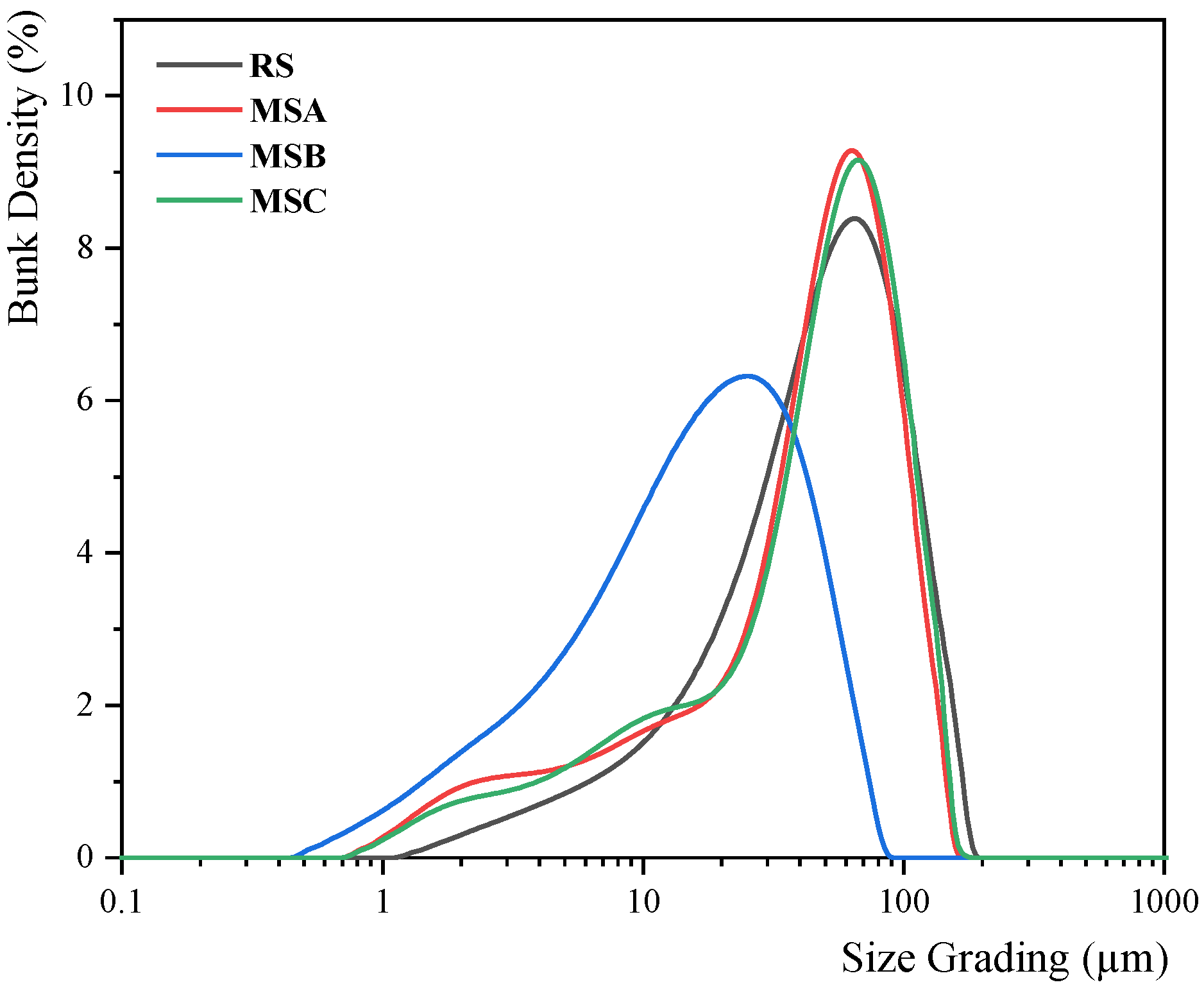

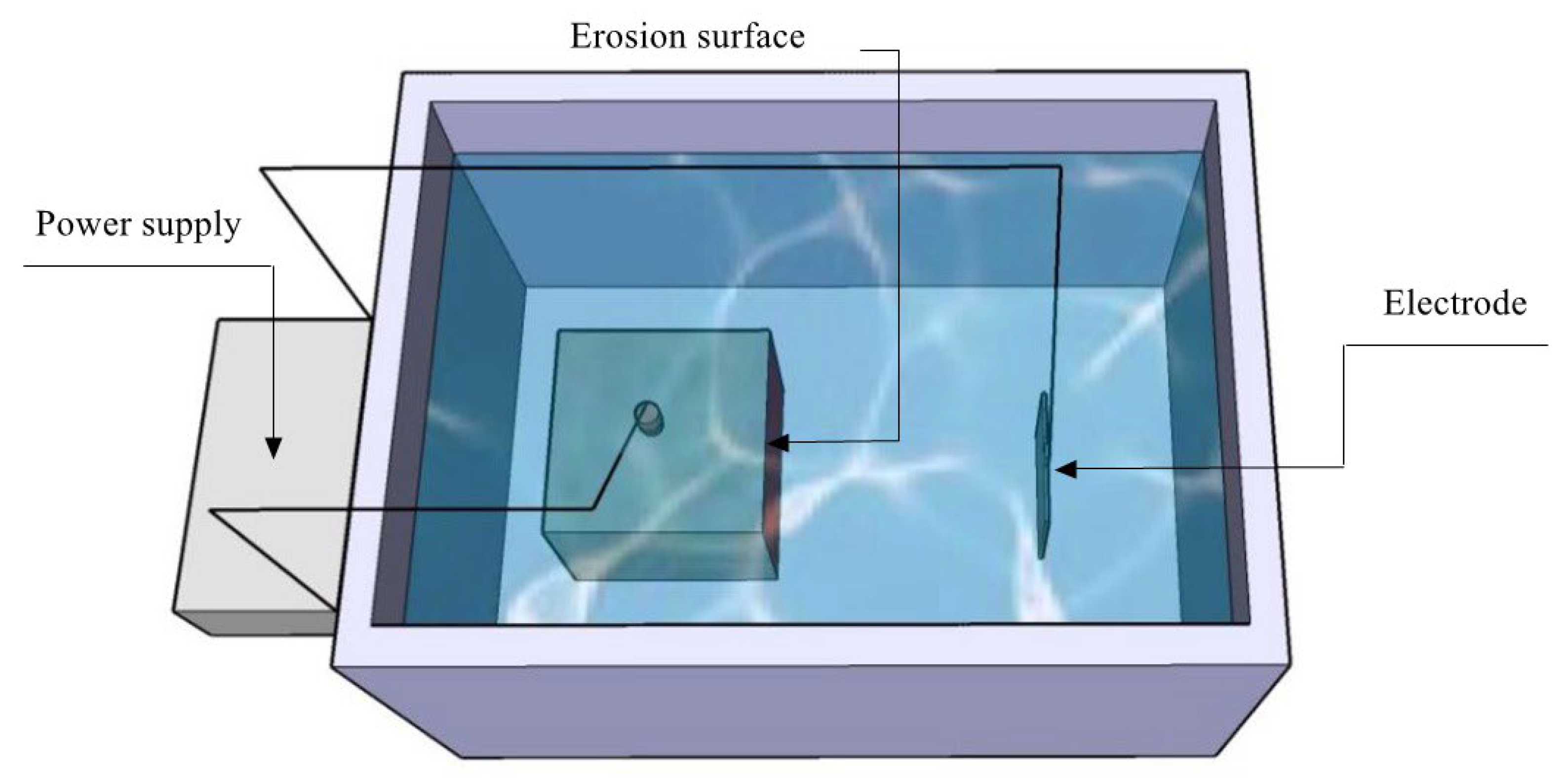

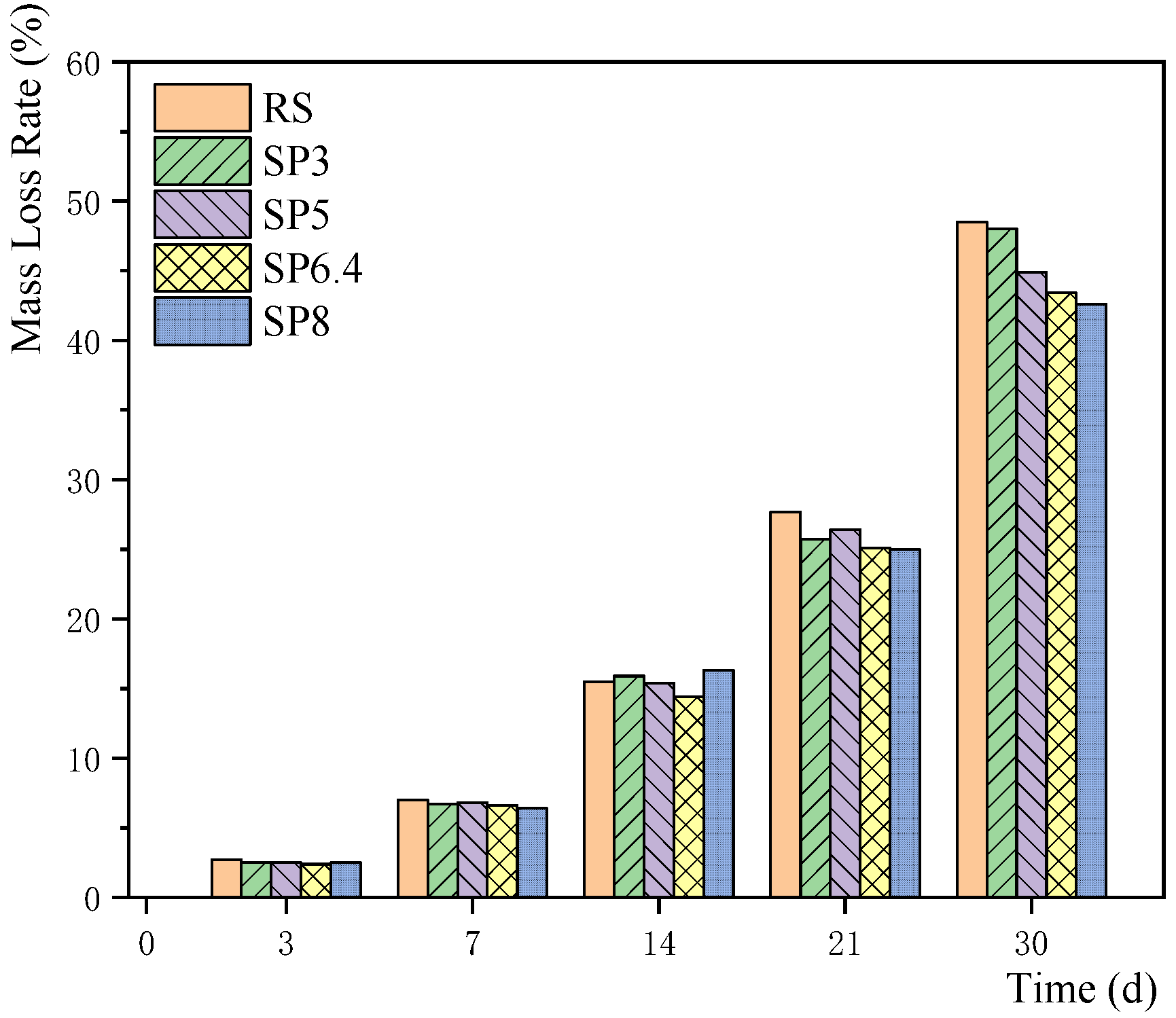

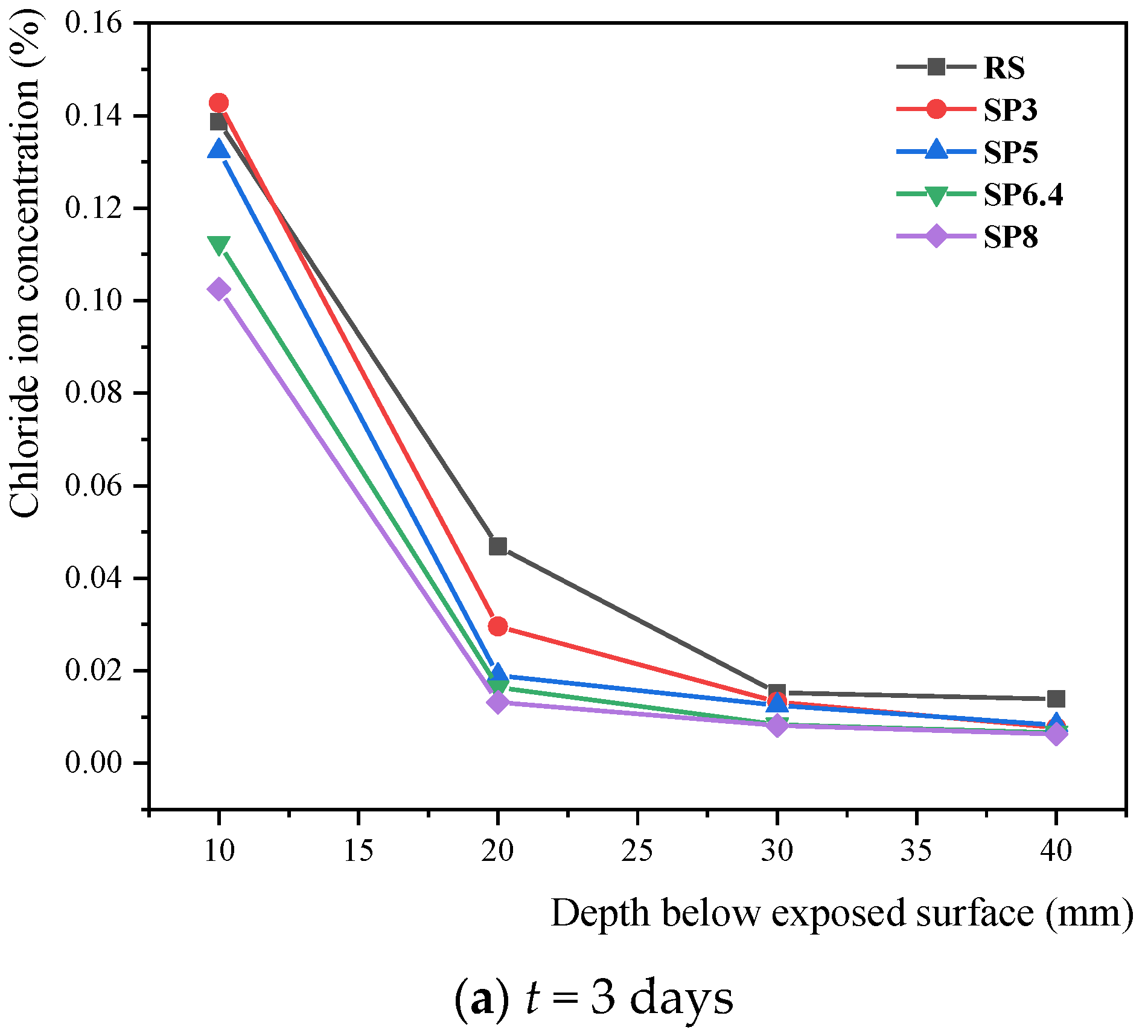
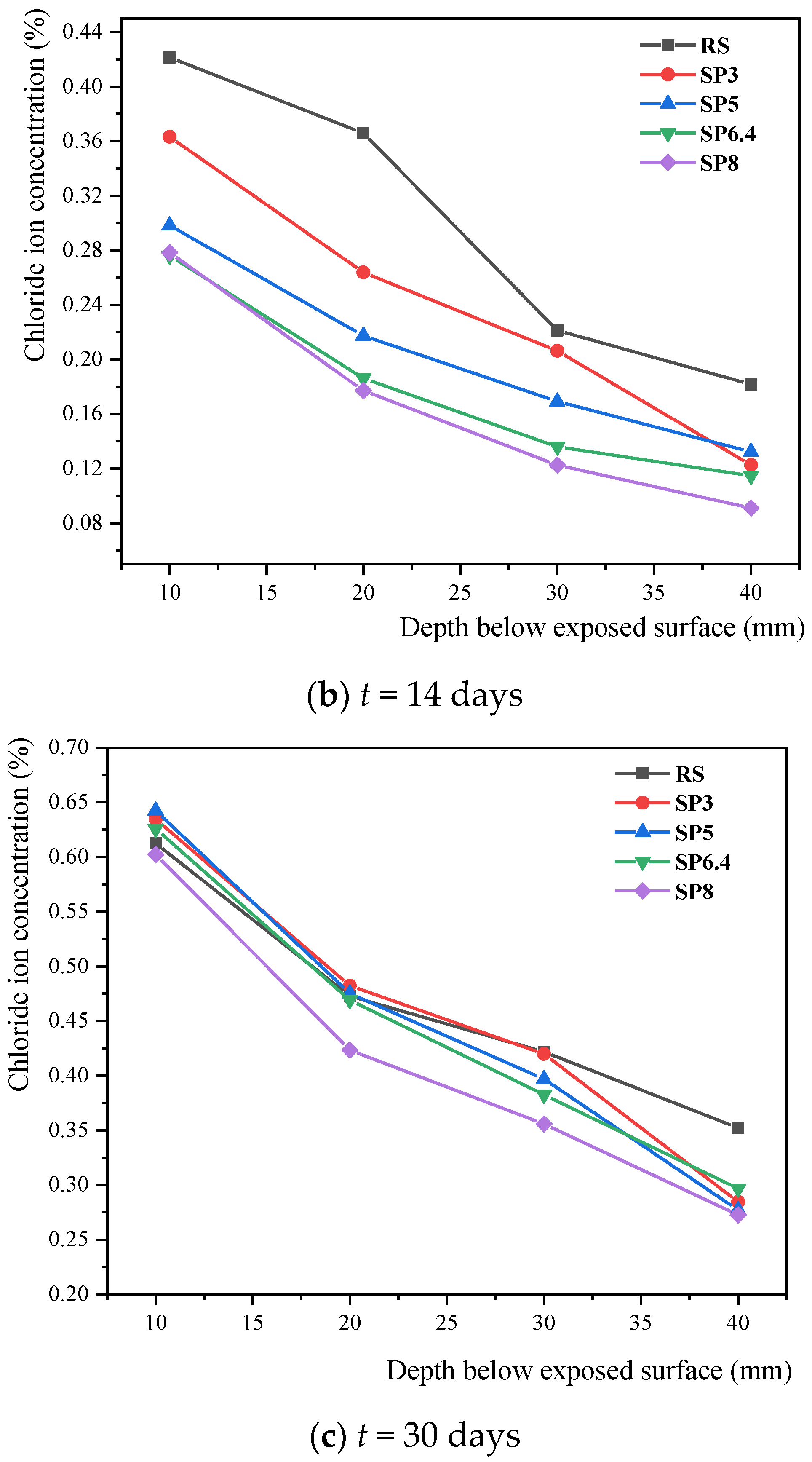
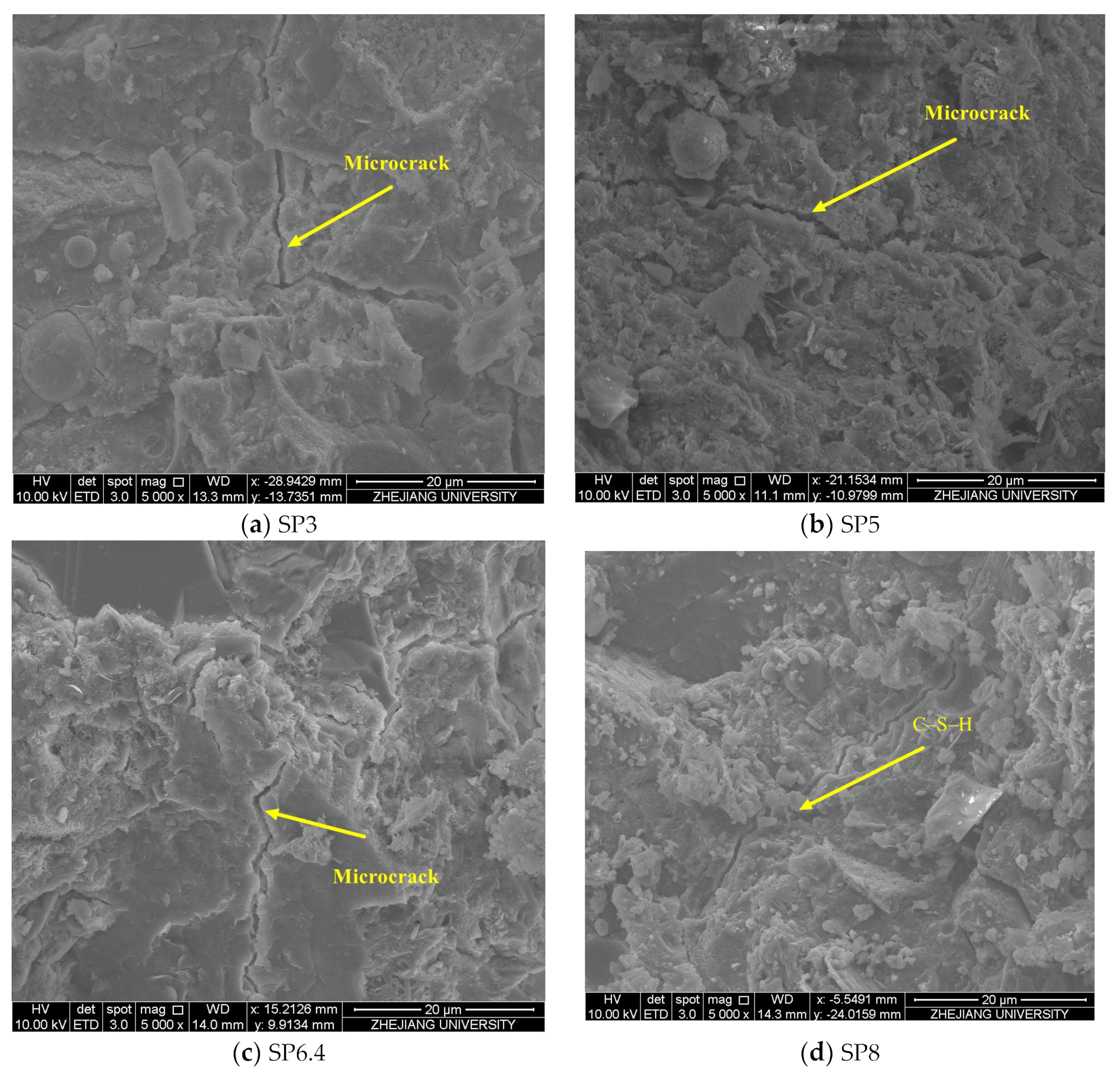
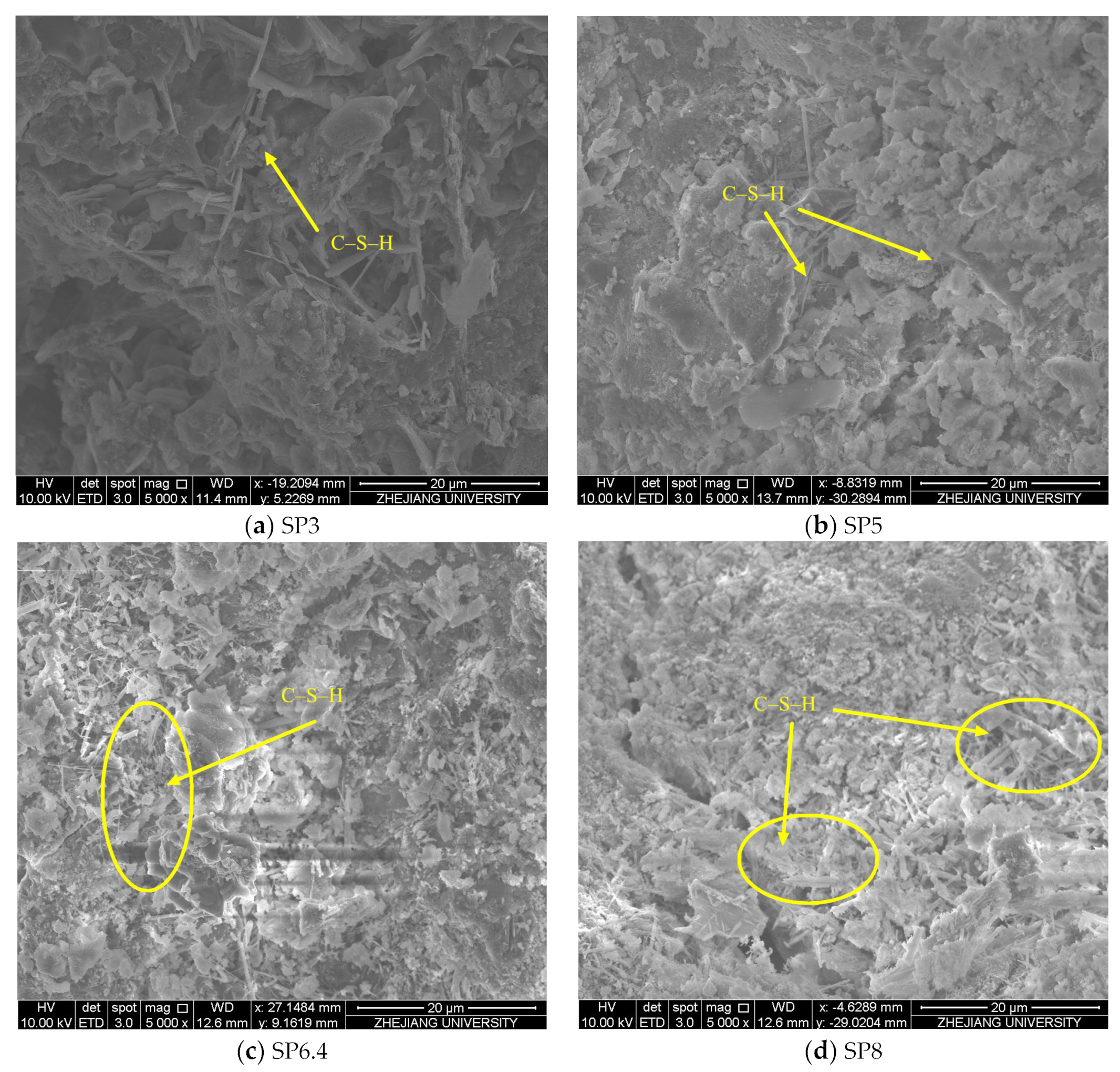
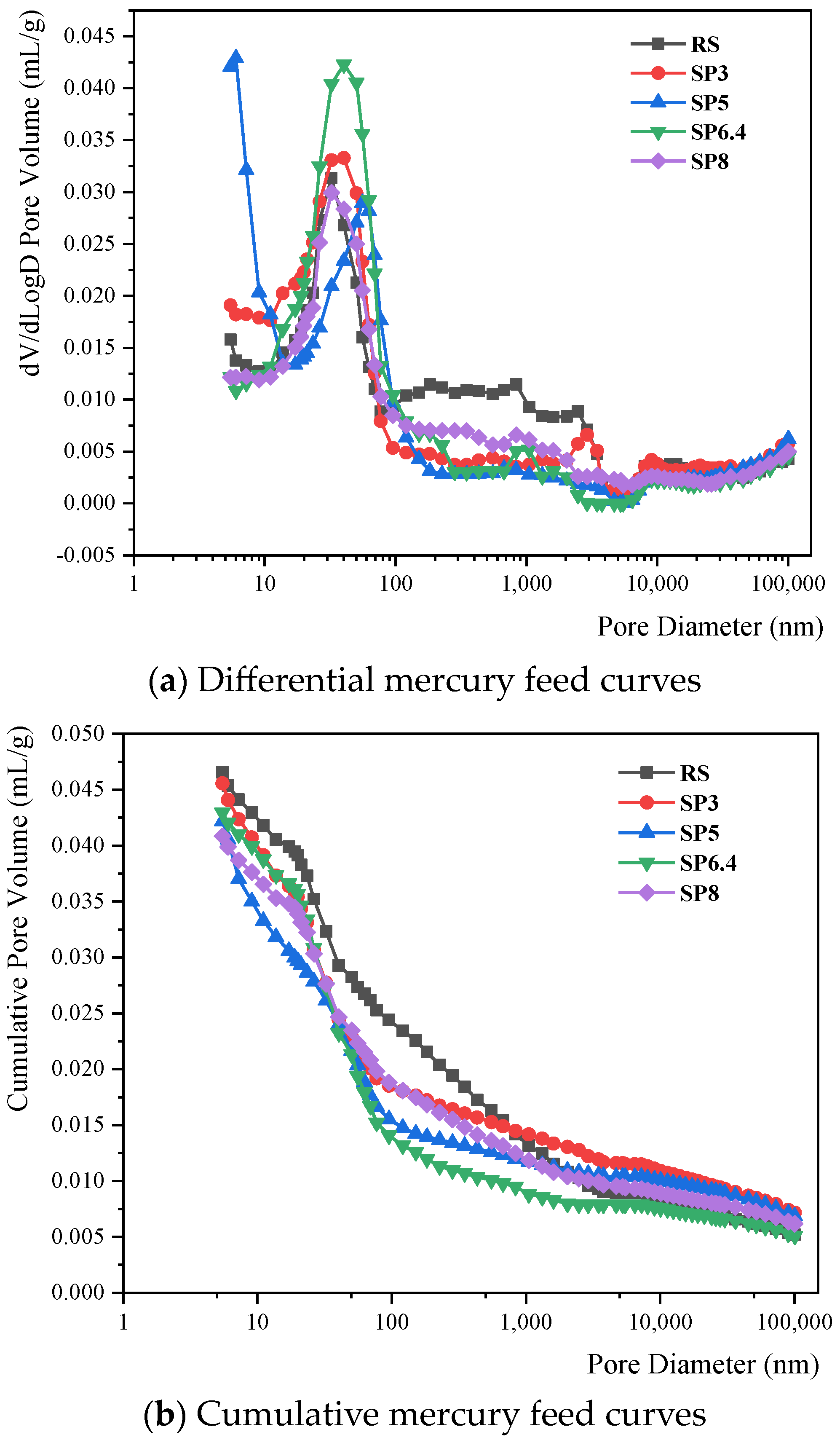

| Property | RS (River Sand) | MSA (Basalt) | MSB (Tuff) | MSC (Pyrophyllite) |
|---|---|---|---|---|
| Fineness modulus | 3.40 | 3.51 | 3.33 | 3.43 |
| Stone powder content (%) | - | 3.65 | 7.31 | 6.42 |
| Mud content (%) | 4.44 | - | - | - |
| MB value for methylene blue | - | 0.96 | 1.72 | 0.99 |
| Ruggedness (%) | 7 | 4 | 6 | 6 |
| Crushing index (%) | 16 | 6 | 12 | 17 |
| Apparent density (kg/m³) | 2600 | 2730 | 2540 | 2570 |
| Bulk density (kg/m³) | 1270 | 1590 | 1450 | 1460 |
| Close-packing density (kg/m³) | 1400 | 1710 | 1620 | 1600 |
| Void ratio | 51 | 42 | 43 | 43 |
| Water | Cement | Sand | Coal Ash | Stone Powder | Coarse Aggregate | Water-Reducing Agent |
|---|---|---|---|---|---|---|
| 158 | 350 | 730 | 60 | 30 | 1070 | 1.32 |
| Number | Condition | River Sand | Manufactured Sand | Stone Powder | Stone Powder Content |
|---|---|---|---|---|---|
| 1 | SP3 | 365 | 354.05 | 10.95 | 3% |
| 2 | SP5 | 365 | 346.75 | 18.25 | 5% |
| 3 | SP6.4 | 365 | 341.64 | 23.36 | 6.4% |
| 4 | SP8 | 365 | 335.80 | 29.20 | 8% |
| 5 | RS | 730 | - | - | - |
| Degree of Corrosion | Icorr (μA·cm−2) |
|---|---|
| Passivated | <0.1 |
| Slight corrosion | 0.1–0.5 |
| Moderate corrosion | 0.5–1 |
| Severe corrosion | >1 |
| Time/d | RS | SP3 | SP5 | SP6.4 | SP8 |
|---|---|---|---|---|---|
| 0 | 1,078,397.2 | 1,030,480.5 | 1,024,407.0 | 1,277,245.8 | 1,354,802.3 |
| 3 | 30,849.9 | 29,590.7 | 32,097.8 | 43,106.2 | 35,950.7 |
| 7 | 5082.0 | 6567.3 | 5023.5 | 8278.9 | 6533.4 |
| 14 | 3581.5 | 3404.3 | 4030.1 | 4399.6 | 4656.0 |
| 21 | 1952.9 | 1828.5 | 2367.6 | 2386.4 | 2801.1 |
| 30 | 1489.2 | 1666.7 | 2205.5 | 2069.7 | 2265.8 |
| Working Condition | Porosity /(%) | Total Pore Capacity/(mL/g) | Total Pore Area /(m2/g) | Average Pore Size (nm) | Most Probable Aperture Size (nm) |
|---|---|---|---|---|---|
| SP3 | 9.8136 | 0.0464 | 6.093 | 30.44 | 40.71 |
| SP5 | 9.5733 | 0.0422 | 7.377 | 22.88 | 29.61 |
| SP6.4 | 9.3728 | 0.0435 | 5.053 | 34.43 | 40.05 |
| SP8 | 8.9628 | 0.0414 | 4.434 | 37.30 | 33.02 |
| RS | 10.1359 | 0.0472 | 4.872 | 38.78 | 32.31 |
Disclaimer/Publisher’s Note: The statements, opinions and data contained in all publications are solely those of the individual author(s) and contributor(s) and not of MDPI and/or the editor(s). MDPI and/or the editor(s) disclaim responsibility for any injury to people or property resulting from any ideas, methods, instructions or products referred to in the content. |
© 2023 by the authors. Licensee MDPI, Basel, Switzerland. This article is an open access article distributed under the terms and conditions of the Creative Commons Attribution (CC BY) license (https://creativecommons.org/licenses/by/4.0/).
Share and Cite
Zhang, Y.; Zhang, X.; Jin, F.; Zhao, X. Impact of Stone Powder Content on Corrosion Resistance in Reinforced Concrete under Stray Current and Chloride Interactions. Materials 2024, 17, 196. https://doi.org/10.3390/ma17010196
Zhang Y, Zhang X, Jin F, Zhao X. Impact of Stone Powder Content on Corrosion Resistance in Reinforced Concrete under Stray Current and Chloride Interactions. Materials. 2024; 17(1):196. https://doi.org/10.3390/ma17010196
Chicago/Turabian StyleZhang, Yuanzhu, Xuanming Zhang, Fan Jin, and Xiuyi Zhao. 2024. "Impact of Stone Powder Content on Corrosion Resistance in Reinforced Concrete under Stray Current and Chloride Interactions" Materials 17, no. 1: 196. https://doi.org/10.3390/ma17010196





